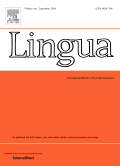Special Issue on Perfectivity and Telicity
In 2005, Raffaella Folli and Heidi Harley organized a workshop at Cambridge University, aimed at bringing together investigators from the two fields and stimulating discussion on the nature of the relationship between the event-structure/aktionsart properties of the vP and the aspectual and temporal predicates that interact with them in the higher domains of the clause. The workshop covered research ranging from Demirdache and Uribe-Etxebarria’s treatment of the interaction of tense, modality and aspect in English all the way down the spine of the clause to Basilico’s investigation of the interaction of roots, particles and aspect in Russian. Zagona introduced a particular previously unaddressed subcase of the interface between aktionsart and viewpoint aspect, what she terms ‘Contained Perfectives’, where the telos of the event is situated within a larger temporal window of viewpoint aspect. Van Hout investigated the complex problem of the acquisition of aspect, discovering that different types of morphological marking of similar aspectual categories may dramatically affect children’s acquisition of the distinctions. Gehrke developed a nuanced analysis of the apparently different effects of ‘source’ particles and ‘goal’ particles on aktionsart properties, showing that a unified account is indeed possible once their distinct monotonic properties are taken into consideration. Ramchand proposed an innovative semantics for viewpoint aspect, giving it a treatment in terms of definiteness, rather than temporal intervals. This special issue brings together the further-developed and connected ideas in the form of a collection of refereed journal articles. The notion that different syntactic domains are structurally and semantically comparable, employing the same syntactico-semantic primitives and the same types of operations is a current theme of broader generative theory: comparisons of DPs to CPs (e.g. Szabolczi 1994) or vPs (Larson 2006) abound, and ‘high/low attachment’ approaches to productive vs. lexical causatives and statives are similarly prevalent (Harley 1995, Kratzer 1996, Marantz 1997, Travis 2000, Embick 2004, Jackson 2005, Svenonius 2005, Alexiadou and Anagnostopolou 2005, among others). This emerging general insight broadly characterizes the proposals collected here as well.

